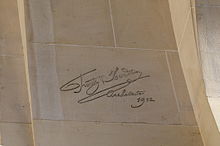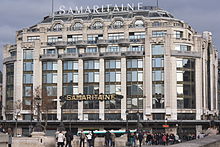Frantz Jourdain
Frantz Jourdain (* as Calixte Raphaël Marie Ferdinand Jourdain on October 3, 1847 in Antwerp , † August 22, 1935 in Paris ) was a writer, art critic, architectural theorist and architect of Art Nouveau . He was the founder of the Salon d'Automne (Paris Autumn Salon) and the architect of the former La Samaritaine de Luxe department store on Boulevard des Capucines in the 2nd arrondissement in Paris. Together with Henri Sauvage (1873–1932) he built the extension of the former department storeLa Samaritaine on Rue du Pont Neuf / Quai du Louvre in the 1st arrondissement in Paris.
family
Frantz Jourdain was the son of an opera singer. He was born in Antwerp when his father, whom his mother accompanied on his tours, was a guest there. The mother, whose circle of friends included Frédéric Chopin , Marceline Desbordes-Valmore and George Sand , devoted herself to music and writing. About his wife, whom he married in 1872 and who was friends with Alphonse Daudet's wife, the friendship developed with Daudet, Émile Zola and Edmond de Goncourt , who promoted his literary ambitions. Frantz Jourdain had a son, furniture designer Francis Jourdain, and two daughters.
School and education
Frantz Jourdain grew up in Paris and first attended the Lycée Henri IV . At times he was tutored by Jules Vallès , whom his mother hired as a tutor. In 1861 he passed the Abitur at the Collège Stanislas . In 1866 Frantz Jourdain was accepted into the École des Beaux-Arts in Paris. There he attended the courses of Honoré Daumet, who was a member of the prestigious Institut de France .
Frantz Jourdain processed his experiences at the École des Beaux Arts in the 1893 novel L'Atelier Chantorel , in which he ridiculed the teaching methods of Honoré Daumet.
In 1870 Frantz Jourdain applied for French citizenship. He volunteered in the Franco-Prussian War of 1870-1871, in which he was wounded and awarded the Medal of Bravery.
career
An inheritance made it possible for Frantz Jourdain to acquire an architectural office in the rue de Richer in the 9th arrondissement , whose customers were keen to get unspectacular buildings at a reasonable price. During his assignments, he experimented with the building materials iron and reinforced concrete .
He received his first major commission in 1876 with the restoration of the La Roche-Guyon castle , which was followed by a number of private houses and villas in the Paris area ( Pantin , Chelles and Saint-Leu). In 1893 he built the Imprimerie Nouvelle in the back courtyard of the Hôtel Cromot du Bourg on Rue Cadet in the 9th arrondissement.
In the 1890s Frantz Jourdain wrote literary works and published articles in various magazines such as La Construction Moderne , Architecture , L'Art Moderne , L'Art Décoratif , Revue des Arts , Revue des Arts Décoratifs and others. a. He supported the campaign by construction workers against the use of the toxic white lead .
In 1902 Frantz Jourdain founded with Auguste Rodin , Adolphe Willette , Albert Besnard , Alexandre Charpentier , Henri Sauvage and Hector Guimard the society Le Nouveau Paris (the New Paris) as a countercurrent to Vieux Paris , the old Paris, with the aim of promoting the art of the avant-garde to promote and open architecture to new techniques and materials. Aware that social needs required a new architectural language, he founded the Société Anonyme des Logements Hygiéniques à Bon Marché (Society for hygienic and inexpensive housing) with Paul Gallimard and Amédée Dherbécourt in 1903 , for which he worked in collaboration with the architect Henri Sauvage and Charles Sarazin built tenement houses in Paris and Le Havre that were supposed to meet the demands for light and air.
In response to the official art exhibition, the Salon de la Société des artistes français , Frantz Jourdain created the Salon d'Automne, the first exhibition of which took place in the Petit Palais in autumn 1903 .
Awards
- 1894: Knight of the Légion d'honneur
- 1900: Officer of the Legion of Honor
- 1926: Grand Officer of the Legion of Honor
Buildings
- 1876: Restoration of La Roche-Guyon castle in the Val-d'Oise department
- 1878: Grave chapel of the Dida family in Draveil in the Essonne department
- around 1887: Villa in Chelles
- 1887: Seven-story tenement house, Rue Hamelin / Rue Galilée No. 9 in the 16th arrondissement of Paris, with Henri Fivaz
- 1888: Factory in Pantin in the Seine-Saint-Denis department
- around 1893: Restoration of the Verteuil Castle
- 1893: Imprimerie Nouvelle , 9–11 rue Cadet in the 9th arrondissement of Paris
- 1894: Town house of the iron merchant Schenck, 9 rue Vergniaud in the 13th arrondissement of Paris
- 1898: Alphonse Daudet's grave in the Père Lachaise cemetery in Paris, in collaboration with the sculptor Alexandre Falguière
- 1899: The La Samaritaine department store is extended by two floors, 75 Rue de Rivoli in the 1st arrondissement of Paris
- 1902: Grave of Émile Zola in the Montmartre Cemetery in Paris
- 1905–1907: Reconstruction of Magasin 2 of the La Samaritaine department store , Rue Baillet / Rue de l'Arbre Sec / Rue de la Monnaie in the 1st arrondissement of Paris
- 1910–12: La Semeuse de Paris residential and office building , 16 rue du Louvre in the 1st arrondissement of Paris
- 1914–1917: La Samaritaine de Luxe department store , 27 Boulevard des Capucines in the 2nd arrondissement of Paris
- 1926–1928: Extension of the La Samaritaine department store , Rue du Pont Neuf / Quai du Louvre in the 1st arrondissement of Paris, in collaboration with Henri Sauvage
- 1930: Le Manoir in Bouffémont in the Val-d'Oise department
- 1930–1933: Extension (Magasin 3) of the La Samaritaine department store , Rue de Rivoli / Rue du Pont-Neuf / Rue Boucher in the 1st arrondissement of Paris
- ? : Restoration of the Châteauneuf-sur-Sarthe castle in the Maine-et-Loire department
Publications (selection)
- L'Atelier Chantorel . Bibliothèque-Charpentier, Paris 1893
- The décorés: ceux qui ne le sont pas . Paris 1895
- Au pays du souvenir . G. Crès, Paris 1922
- Le Salon d'automne . Les Arts et le livre, Paris 1926
- Feuilles mortes et fleurs fanées . Paris 1931
literature
- Meredith L. Clausen: Frantz Jourdain and the Samaritaine: Art Nouveau theory and criticism . EJ Brill, Leiden 1987, ISBN 90-04-07879-7 .
- Jean Colson, Marie-Christine Lauroa (ed.): Dictionnaire des Monuments de Paris . Éditions Hervas, Paris 2003 (1st edition 1992), ISBN 2-84334-001-2 .
- Franco Borsi, Ezio Godoli: Parisian buildings at the turn of the century. Architecture and design of the French metropolis around 1900 . Nikol Verlagsgesellschaft, Hamburg (no year), ISBN 3-930656-65-5 .
- Les Cathédrales du Commerce Paris. Grands Magasins et enseignes . Collection Paris et son Patrimoine, Action Artistique de la Ville de Paris (ed.), Paris 2006, ISBN 2-913246-57-5 .
Web links
- Frantz Jourdain in the Base Mérimée of the French Ministry of Culture (French)
- Photos for La Samaritaine
Individual evidence
- ^ Frantz Jourdain . Archives Nationales, Dossier: LH / 1380/76.
- ↑ Chapelle funéraire de la famille Dida in the Base Mérimée of the French Ministry of Culture (French)
- ↑ Le Patrimoine des Communes du Val-d'Oise . Volume 1, Flohic Éditions, Paris 1999, ISBN 2-84234-056-6 , p. 182.
| personal data | |
|---|---|
| SURNAME | Jourdain, Frantz |
| ALTERNATIVE NAMES | Jourdain, Calixte Raphaël Ferdinand Marie |
| BRIEF DESCRIPTION | Franco-Belgian architect, writer, art critic |
| DATE OF BIRTH | October 3, 1847 |
| PLACE OF BIRTH | Antwerp , Belgium |
| DATE OF DEATH | August 22, 1935 |
| Place of death | Paris |






